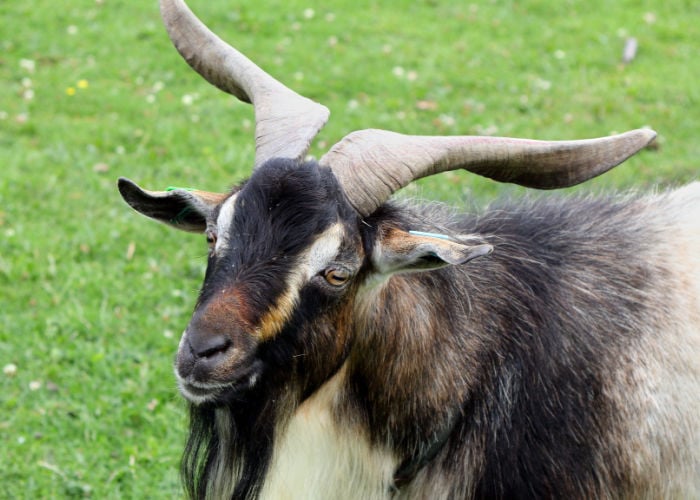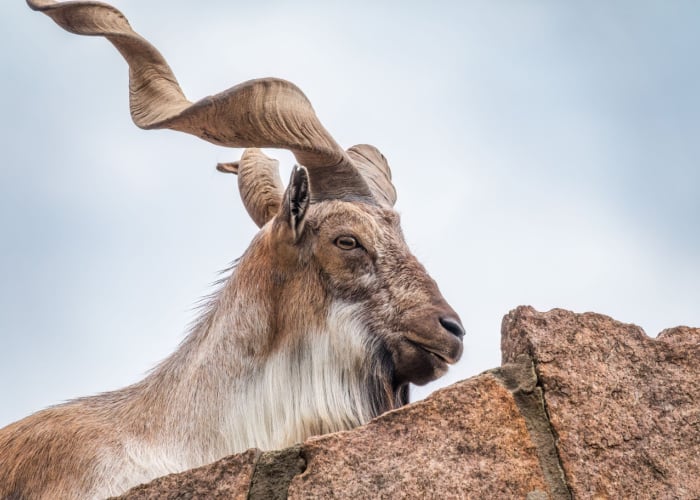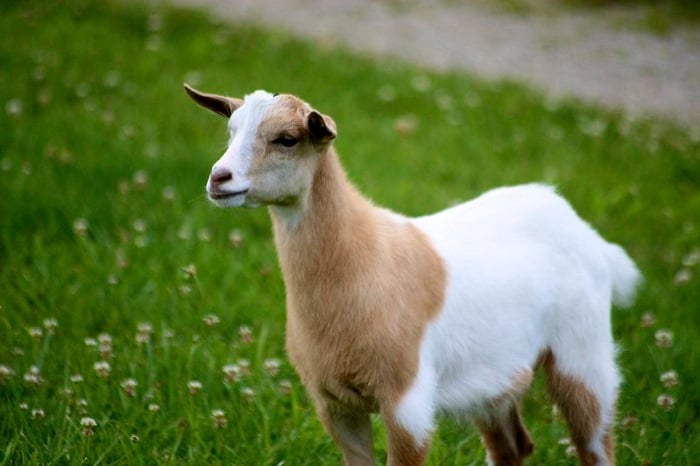If you think goats are just your average barnyard animal, think again!
While there are the classic breeds like the Boer or the Alpine, the goat world is also full of some truly bizarre specimens.
Fromcurly-coated goatsthat look like they went through a perm to goats that tower over humans, we’re about to take a deep dive into the wonderful world of unusual and weird goat breeds!
15 Weird Goat Breeds
Here are some of the most unusual goat breeds to consider adding to your herd.
1. Damascus Goat
If you’ve ever seen a picture of a Damascus goat, you’ll understand why we put it at the top of our list!
TheDamascus goathails from the Middle East and is named after the city of Damascus in Syria.
They are also known asAleppo goats, as they originate from thenorthern regions of Syria.
The hair of the Damascus goat isthick and shaggy,which gives it a unique appearance.
Thehair covers their entire body,including their ears and faces, which gives them a furry appearance.
They have faces that are almostwrinkly in appearance– they’re just not beautiful creatures!
In terms of their size, Damascus goats are medium to large-sized animals and can weigh between100 to 200 pounds.
They are known for their strength and agility and can climb steep hills and rocks with ease.
They are also known for their resilience and can withstand harsh climates and environments, making them a great choice for areas with extreme weather conditions.
Damascus goats are primarily raised for their milk production, as they are known to be heavy milkers.
它们产生丰富、高但奶油牛奶terfat and protein, which is excellent for making cheese and other dairy products.
They are also raised for their meat, which is lean and has a unique flavor.
Damascus goats are known to be very social and friendly animals and make great companions for humans.
They are intelligent and can be trained to do tricks and follow commands, making them great for leisure and entertainment.
2. Arapawa Goat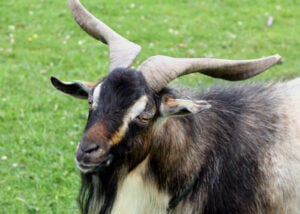
TheArapawa goat, also known as the “New Zealand Arapawa Island Goat,” is a rare breed of domestic goat that originated on Arapawa Island in New Zealand.
These goats have a fascinating history and adistinctive appearancethat makes them one of the most intriguing goat breeds in the world.
The Arapawa goat breed is believed to be the descendant of goats brought to New Zealand from Europe by the whalers in the 1600s.
Eventually, these goats were released onto Arapawa Island, where they roamed andbred for over 150 years.
Since the island is isolated and has diverse flora and fauna, the goats evolved to adapt to their environment, creating a distinct breed from their European ancestors.
These goats have arugged and wild lookthat sets them apart from the other domestic goat breeds.
They have amuscular physique, with short, thick legs that make them agile and able to climb steep slopes and jump over fences.
Their coats range from light to dark brown; some even have black and white markings.
Theirears are pointed, and their face is usually free of any facial hair, making them look almost like deer.
It is important to note that every Arapawa goat looks unique, making it difficult to find two that are identical.
3. Angora Goats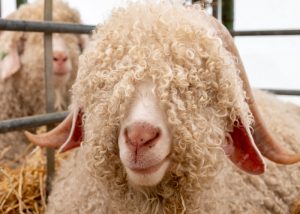
These goats一个re widely known for theirlong, silky hair that is curly and lustrous.
The most unique characteristic of these goats is their hair, which is not like any other goat.
The hair is not onlyused for textile productionbut also formaking luxurious clothinglike scarves, sweaters, and shawls.
The hair of the Angora goats is carefullysheared off twice a yearby the farmer, who then spins it into yarn.
This fiber has a silky texture that high-end fashion brands across the world seek after.
4. Old Irish Goat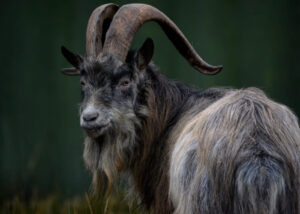
The Old Irish Goat is a domesticated breed that has been in Ireland for centuries.
It is believed to have descended from thewild goatsthat roamed the Irish mountains.
These goats were the main source of food, milk, and wool for the people of Ireland, and they were an essential part of their daily lives.
However, with the introduction of modern farming methods and other breeds of goats, the Old Irish Goat population started to decline.
In the 1970s, a group of passionate individuals took action to preserve this breed and established theOld Irish Goat Society.
Today, the population of Old Irish Goats has increased, but they remain a rare breed.
The Old Irish Goat is a medium-sized animal that has a distinctive appearance.
Itscoat is long and shaggy一个nd comes in a variety of colors, including black, brown, and white.
It haslong, curved hornsthatgrow backward from the head一个nd are used for defense and fighting.
The Old Irish Goat is also known for itsstrong, muscular body,它允许它将容易在陡峭的地形。
Its hooves are broad and have a firm grip, which makes it an excellent climber.
Unlike other goat breeds, the Old Irish Goat has a very laid-back personality and is known for its gentle nature.
The Old Irish Goat has been a significant part of Irish culture and folklore for centuries.
In addition, goat’s milk and cheese are an important part of the Irish diet, and their wool is used to make traditional clothing and blankets.
The goat has had a significant role in many Irish festivals and celebrations, such as thePuck Fair in Killorglin, where a wild goat is crowned king for three days.
5. Bilberry Goat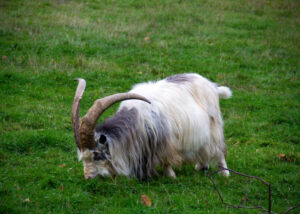
The origin of these goats is still unclear, but it is believed that they have been roaming the hills of Cumbria for hundreds of years.
Bilberry goats一个re well-adapted to the harsh mountain environment, with thick fur that protects them from cold and wet weather.
They are one of the hairiest goat breeds, with theirlong and shaggy coat.
No wonder because Bilberrys are said to be related to Pashmina, Cashmere, and Maltese goats.
6. Bagot Goats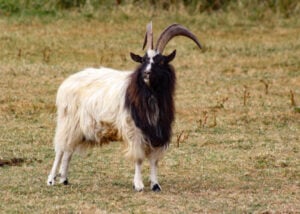
Next up is theBagot Goat– a small and sturdy breed that originated in the Lake District in the UK.
Unlike the Bilberry goat, which is wild and largely unmanaged, Bagot goats are kept in small herds by farmers who appreciate their hardy nature and ease of care.
They are small to medium in size –一个round 50-60cm tall– but what sets them apart is their unique facial features.
Bagot goats havelarge, curved hornsthat curl backward around their ears, giving them a distinctive and almost regal appearance.
Their coat color is usually black or brown, but some individuals can be speckled or even white.
7. Oberhasli Goats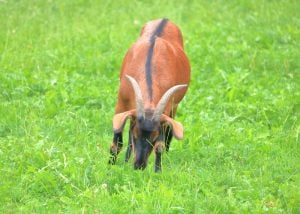
The Oberhasli goat,一个lso known as the Swiss Alpine goat, originated in Switzerland.
Its name came from Oberhasli, a region near Bern, Switzerland, where it was bred for centuries.
This breed is highly adaptable, able to survive harsh weather conditions such as cold winters and hot summers.
Its coat color ranges from chamois to bay, with itsstriking black dorsal striperunning from the head to its tail.
This goat breed is medium-sized, standing up to 30 inches at the withers.
Females in this breed can produce 2 to 3 liters of milk daily, which is rich in butterfat, protein, and minerals.
One aspect that sets the Oberhasli goat apart from other breeds is its docile temperament.
Its amiability makes it easy for farmers to manage, which is why it’s often kept as a pet.
It is also known for its intelligence and curiosity, always eager to explore and discover new things.
Oberhasli goats make wonderful companions that adore being around people.
They are known to follow their owners like dogs and enjoy receiving cuddles and attention.
The Oberhasli goat is often raised for its milk production, but it also has many other purposes.
It is often used as a pack animal, capable of carrying loads up to 25% of its body weight.
8. Madurai Goat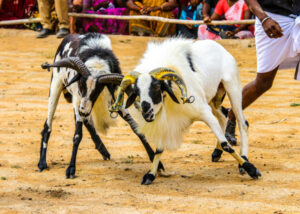
The Madurai Goat has its origins in the Madurai district of Tamil Nadu, India, hence its name.
This hardy breed was specifically developed for dairy and meat production.
It’s also known for its high fertility rate, fast growth rate, and adaptability to harsh weather conditions.
The goat is an excellent grazer and can survive on sparse vegetation, making it a popular choice among farmers.
Unlike other breeds, the Madurai Goat’s body is covered withfrizzy wool-like hair.
This hair is long, curly, and dense and helps protect the goat from the sun and other harsh environmental conditions.
The Madurai Goat has athick neck, broad chest, and muscular legsthat give it a sturdy and robust appearance.
It also has adistinctive Roman nose,broad ears, and a short but sturdy tail, making it easily recognizable.
9. Golden Guernsey Goats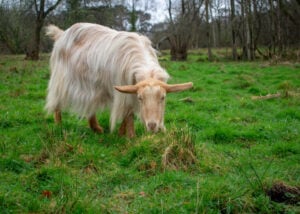
TheGolden Guernsey goatis a rare breed of domestic goat from the Channel Islands.
It used to be a popular breed in the 1950s, but its population declined fast because of crossbreeding and the introduction of other breeds that produced more milk.
By the 1970s, there were only a handful of Golden Guernsey goats left in the world, and the breed was officially declared “rare” by theRare Breeds Survival Trustin the UK.
Today, there are still less than 1,000 Golden Guernsey goats worldwide, with most of them found in the UK.
One of the most distinctive features of the Golden Guernsey goat is, of course, itsgolden color.
This bright shade varies from pale blonde to deep caramel and can be solid or have lighter spots on the ears and forehead.
The fur is long, silky, and often combed by the goats themselves to keep it clean and shining.
The Golden Guernsey goat is also a small breed, with does weighing around 60-70 lbs and bucks around 100-120 lbs.
This makes them easy to handle and perfect for hobby farms or small homesteads.
Another reason why the Golden Guernsey goat is so unusual is its milk.
Unlike other dairy goats, the Golden Guernsey goatproduces a unique, creamy milkthat is rich in butterfat and protein but doesn’t have the “goaty” taste that some people find off-putting.
This makes the milk ideal for making cheese, yogurt, and ice cream, as well as for drinking and cooking.
10. Miniature Alpine Goats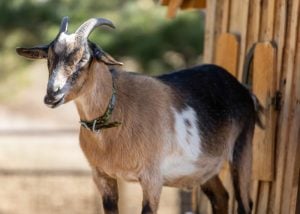
Miniature Alpine Goats are a relatively new breed that originated in America.
As their name suggests, they are a smaller version of thetraditional Alpine Goat breed一个nd only stand about22-28 inches tall一个t the shoulder.
They come in a variety of colors, including black, brown, white, and gray.
What sets these goats apart from others is theirfriendly and outgoing personality, along with their high milk production.
They produce between 3-4% butterfat milk, making them a desirable choice for dairy farmers who want a smaller herd size.
11. Dutch Landrace Goats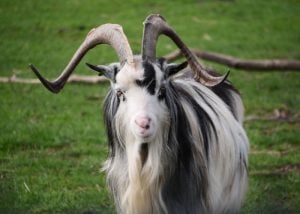
Originating from the Netherlands, these goats are known for their striking appearance, especially theirlong, twisted hornsthat can reach up to 1 meter long!
And while their coat color varies, they usually have awhite or beige undercoat with black or brown spots all over.
But what makes them truly unique is their一个bility to adapt to harsh environments.
Dutch Landrace goats can survive in extreme weather conditions, such as intense heat or heavy rainfall.
They’re also resistant to many common goat diseases, which makes them an ideal breed for farmers.
12. Ibex Goats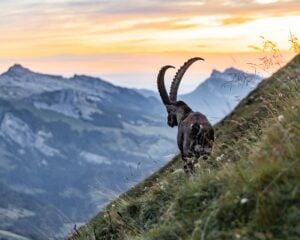
Next, we have the Ibex goats, which are native to the mountain regions of Europe, Asia, and Africa.
Unlike most domesticated breeds, Ibex goats are wild and can climb steep cliffs with ease, using theirsharp hooves and muscular legs.
Theirlong, curved horns一个re another standout feature that both males and females possess.
Ibex山羊有shaggy brown coatthat helps protect them in cold weather, and they rely on theirexcellent eyesightto navigate their surroundings.
These goats are not commonly kept as pets because of their wild nature, but they’re popular among hunters and wildlife enthusiasts.
13. Rove Goats
These goats are native to the Alps and have evolved to survive in rocky, mountainous terrain.
They have ashort, wiry coatwith a distinctive black stripe running down their spine.
Theircurved horns一个re also unique, with males having larger and more elaborate horns than females.
What sets Rove goats apart is theirresourcefulness.
These goats are skilled at finding food and water sources in their harsh environment, and they can even jump several feet highto reach vegetation.
They’re also used to produce fine milk, which is highly valued in Italy and France for its flavor.
14. Toggenburg Goat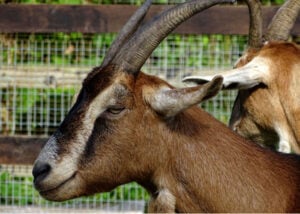
The Toggenburg Goatis a breed that originated in Switzerland and is named after the Toggenburg Valley, where they were first bred.
他们最为人所知的唯一的一个ppearance, with abrown body and white stripes一个long their face and legs.
They are also one of the oldest registered goat breeds in the world, with records of their existence dating back to the early 1600s.
Besides their appearance, Toggenburg goats are valued for their milk production, which is relatively high compared to other goat breeds.
Additionally, they have a docile and friendly temperament, making them a popular choice for hobby farmers or those looking to add a family-friendly animal to their homestead.
15. Valais Blackneck Goat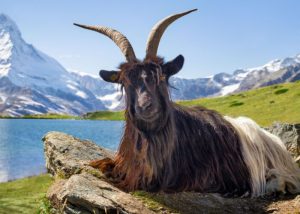
Have you ever seen a goat with a mullet? Look no further than the Valais Blackneck.
The Valais Blackneck Goat is a breed that hails from Switzerland, too.
They are characterized by theirunique, striking coat pattern,包括(鲻鱼)和一个黑色的头neck and a rust-colored body.
The design of their coat has earned them the nickname“Panda Goat”or“Oreo Goat.”
Not only are they visually stunning, but they are alsorobust and hardy.
They are well-suited for harsh outdoor environments like mountains and chilly weather thanks to their thick and long hair.
Weird Goat Breeds: Before You Go…
There you have it – some of the wackiest and most unusual goat breeds out there!
Whether you’re looking for an eye-catching addition to your farm or just want to impress your friends with some fun goat facts, these breeds are sure to amaze.
Plus, who knows – maybe someday you’ll even be able to get your own Valais Blackneck with a mullet and be the coolest farmer on the block.
Interested to learn more fun facts about different goat breeds?
Below are some recommended reads for you to check out!
















